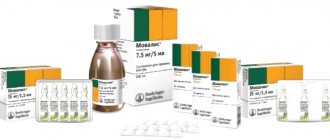Composition and pharmaceutical form
The active substance of the drug is lornoxicam, which belongs to the group of non-steroidal anti-inflammatory drugs. The drug has a pronounced analgesic effect without affecting the thermoregulation centers and the cardiovascular system.
Xefocam is produced in the form of a lyophilized powder, soluble in water. The light yellow dense mass is packaged in dark glass bottles. One dose of the drug contains 8 mg of lornoxicam and stabilizing additives, including mannitol, trometamol. When combined with a liquid, the drug is converted into a homogeneous colored solution.
The injections are intended for parenteral administration: intravenously and intramuscularly. One cardboard package of Xefocam contains 5 bottles of lyophilized dry mass.
Contraindications to the use of the drug Xefocam
Hypersensitivity to lornoxicam or other components of the drug, a history of indications of hypersensitivity to acetylsalicylic acid or other NSAIDs (ibuprofen, indomethacin), hemorrhagic diathesis or blood coagulation disorders, gastric and duodenal ulcers in the acute phase, nonspecific ulcerative colitis, severe disorders liver function, moderate or severe renal impairment (serum creatinine level 300 µmol/l), hypovolemia or dehydration, confirmed or suspected hemorrhagic stroke, asthma, heart failure, decreased hearing acuity, glucose-6-phosphate dehydrogenase deficiency, pregnancy and lactation breastfeeding, age up to 18 years.
How does Xefocam work?
The analgesic effect of Xefocam is higher than that of similar NSAID-based drugs. The active component of the drug blocks the release of pain and inflammatory mediators without having an antipyretic effect. Thanks to this, acute symptoms of diseases of the joints and spine are relieved.
The use of the drug does not cause disturbances in the central nervous system, does not change the level of blood pressure and heart rate. Xefocam does not accumulate in body tissues and does not provoke addiction or drug dependence, despite its strong symptomatic effect.
Unlike the tablet form, Xefocam injections reduce pain within 5–10 minutes. The effect of one dose lasts for 0.5–1 day. In addition, parenteral administration of the drug reduces the risk of irritation of the gastric mucosa.
The transformation of Xefocam occurs in the liver. Part of the active substance remains unmetabolized and is excreted through the kidneys. Residues of NSAIDs leave the body with intestinal contents within 24 hours. In people with reduced liver function, the duration of drug elimination is prolonged.
Pharmacological properties of the drug Xefocam
It has a pronounced analgesic and anti-inflammatory effect. Lornoxicam has a complex mechanism of action, which is based on inhibition of prostaglandin synthesis due to inhibition of the activity of COX isoenzymes. In addition, lornoxicam inhibits the release of oxygen free radicals from activated leukocytes. The analgesic effect of lornoxicam is not associated with narcotic effects. The drug Xefocam does not have an opiate-like effect on the central nervous system and, unlike narcotic analgesics, does not depress respiration and does not lead to the development of drug dependence. After oral administration, lornoxicam is quickly and almost completely absorbed into the gastrointestinal tract. The maximum concentration in the blood plasma is achieved 1-2 hours after taking the drug orally, and with intramuscular administration - after 0.4 hours. The absolute bioavailability of lornoxicam is 90-100%. Lornoxicam is present in blood plasma mainly unchanged and, to a lesser extent, in the form of a hydroxylated metabolite that does not have pharmacological activity. The binding of lornoxicam to plasma proteins, mainly to the albumin fraction, is 99% and does not depend on its concentration. The half-life averages 4 hours and does not depend on the concentration of the drug. Lornoxicam is completely metabolized in the body. 1/3 of the metabolites are excreted in the urine, 2/3 in the bile. In elderly people, as well as in patients with renal or hepatic insufficiency, significant changes in the pharmacokinetics of lornoxicam were not detected.
For what pathologies is Xefocam indicated?
Injections are prescribed intramuscularly and intravenously to eliminate the inflammatory process and acute pain:
- during attacks of lumbodynia caused by intervertebral hernias, pinched nerve endings of the spine, exacerbations of osteochondrosis, spondyloarthrosis;
- for sciatica;
- with neuralgic attacks;
- for injuries of the vertebrae and joints;
- during the recovery period after surgery;
- for chronic symptoms of rheumatism, osteoarthritis and arthritis of various origins.
Xefocam does not affect the general course of the disease, but significantly improves the physical condition, reducing acute pain and restoring the limited mobility of the musculoskeletal system.
Indications for use of the drug Xefocam
for oral administration:
- moderate or severe pain (for example, spinal pain, lumbago/sciatica, pain in the postoperative period, myalgia);
- symptomatic treatment of pain and inflammation in inflammatory and degenerative rheumatic diseases.
For parenteral use:
- pain in the postoperative period and during injury;
- pain syndrome associated with an acute attack of lumbago, ischalgia.
Method of using Xefocam injections: instructions
The injection solution is prepared immediately before use. The dose of the drug from the bottle is diluted in 2 ml of distilled water. Use syringes with a long needle.
- With an intramuscular injection, the administration of the medicine lasts 5 seconds;
- intravenous administration should last at least 15 seconds.
The daily dose of the drug is 8–16 mg. In case of particularly acute pain, an additional single injection is allowed. The break between injections should be at least 9 hours.
Course of treatment with Xefocam: up to 5 days. For moderate pain, it is recommended to reduce it to 2-3 days. A single injection of the solution without repeating injections is possible in case of unexpectedly developing attacks of pain and in subacute conditions.
Side effects of the drug Xefocam
from the gastrointestinal tract and liver: abdominal pain, diarrhea, dyspepsia, nausea, vomiting; rarely - flatulence, dry mouth, gastritis, esophagitis, formation of peptic ulcers and/or gastrointestinal bleeding (including rectal bleeding), stomatitis, glossitis, colitis, dysphagia, hepatitis, pancreatitis, liver dysfunction. Allergic reactions: possible skin rash, hypersensitivity reactions accompanied by shortness of breath, tachycardia, bronchospasm, Stevens-Johnson syndrome, exfoliative dermatitis, angitis, fever, allergic rhinitis, lymphadenopathy. From the central nervous system: rarely - dizziness, headache, drowsiness, agitation, sleep disturbances, tinnitus, hearing loss, dysarthria, hallucinations, migraine, peripheral neuropathy, syncope, aseptic meningitis. From the senses: visual impairment, conjunctivitis. From the blood system: rarely - leukopenia, thrombocytopenia. Metabolic disorders: rarely - increased sweating, chills, changes in body weight. From the cardiovascular system: rarely - hypertension (arterial hypertension), tachycardia, peripheral edema. From the urinary system: rarely - dysuria, in some cases - glomerulonephritis, papillary necrosis and nephrotic syndrome with transition to acute renal failure, interstitial nephritis, crystalluria, polyuria.
Side effects and contraindications
With short-term use of Xefocam, adverse reactions to it rarely develop. Among the possible:
- dyspepsia: loss of appetite, nausea, discomfort and pain in the stomach;
- visual impairment;
- decreased sensitivity of various parts of the body;
- tremor;
- dizziness;
- asthenia, physical weakness;
- change in blood formula;
- increased liver transaminases;
- decrease in diuresis.
People with dysfunction of internal organs have a higher risk of side effects; they need to reduce the dosage of the drug and monitor laboratory parameters.
It is necessary to stop using Xefocam for the following diseases and conditions:
- gastric ulcer and ulcerative colitis;
- tendency to internal bleeding;
- severe liver or kidney failure;
- with hematopoietic disorders, insufficient hemostasis;
- during the recovery period after internal organ transplantation;
- with severe heart failure;
- with Crohn's disease.
It is also not recommended to use Xefocam during pregnancy, as it can negatively affect the development of the fetus, increases the risk of premature placental abruption, and complicates the birth process. Nursing mothers, children and adolescents under 18 years of age need to choose less strong painkillers due to the imperfections of the young body.
Xefocam®
The risk of ulcerogenic effects of the drug can be reduced by the simultaneous administration of proton pump inhibitors and synthetic prostaglandin analogues. If bleeding occurs in the gastrointestinal tract, the drug should be stopped immediately and appropriate emergency measures taken. It is especially necessary to carefully monitor the condition of those patients with gastrointestinal pathology who are receiving a course of treatment with XEFOCAM for the first time.
Like other oxicams, XEFOCAM inhibits platelet aggregation and may therefore increase bleeding time. When using this drug, carefully monitor the condition of patients who require completely normal functioning of the blood coagulation system (for example, patients who are undergoing surgery), have disorders of the blood coagulation system, or are receiving drugs that inhibit coagulation (including low-dose heparin ), in order to promptly detect signs of bleeding.
If signs of liver damage appear (itching, yellowing of the skin, nausea, vomiting, abdominal pain, dark urine, increased levels of liver transaminases), you should stop taking the drug and consult your doctor.
The drug should not be used simultaneously with other NSAIDs.
The drug can change the properties of platelets, but does not replace the preventive effect of acetylsalicylic acid in cardiovascular diseases.
In patients with impaired renal function caused by large blood loss or severe dehydration, XEFOCAM, as an inhibitor of prostaglandin synthesis, can be prescribed only after hypovolemia and the associated risk of decreased renal perfusion have been eliminated. Like other NSAIDs, XEFOCAM can cause an increase in blood urea and creatinine concentrations, as well as water and sodium retention, peripheral edema, hypertension and other early signs of nephropathy. Long-term treatment of such patients with XEFOCAM can lead to the following consequences: glomerulonephritis, papillary necrosis and nephrotic syndrome with transition to acute renal failure. Patients with a pronounced decrease in renal function should not be prescribed XEFOCAM (see “Contraindications”). In elderly patients, as well as in patients suffering from arterial hypertension and/or obesity, it is necessary to control blood pressure levels. It is especially important to monitor renal function in elderly patients, as well as in patients:
- simultaneously receiving diuretics;
- concurrently receiving medications that can cause kidney damage.
With long-term use of the drug XEFOCAM, it is necessary to periodically monitor hematological parameters, as well as renal and liver function.
The use of the drug may adversely affect female fertility and is not recommended for women planning pregnancy.











